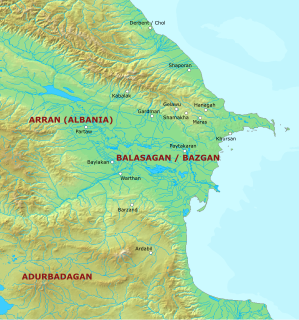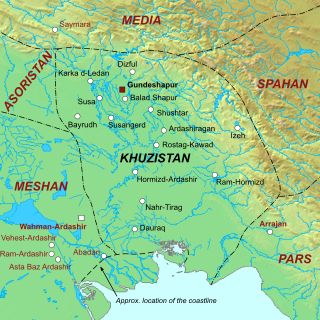 W
WAdurbadagan was a Sasanian province located in northern Iran, almost corresponded to the present-day Iranian Azerbaijan. Governed by a marzban ("margrave"), it functioned as an important frontier region against the neighbouring country of Armenia.
 W
WArdashir-Khwarrah was one of the four administrative divisions of the Sasanian province of Pars. The other administrative divisions were Shapur-Khwarrah, Istakhr and Darabgerd, while a fifth named Arrajan was founded in the early 6th century by Kavadh I.
 W
WBalāsagān, also known as Bazgan, was a region located in the area of the Kura and Aras rivers, adjacent to the Caspian Sea. To the south, it bordered Atropatene/Adurbadagan and Gilan. It roughly corresponded to the Armenian province of Paytakaran, albeit extending farther into the north. It has been suggested that under the Sasanians the region extended as far as the stronghold of Derbent, albeit this remains disputed. The heartland of Balasagan was the Dasht i-Bałasakan which corresponds to the Mughan plain. During the late Sasanian era, Balasagan was included in the northern quadrant (kust) of Adurbadagan.
 W
WKhuzistan or Huzistan was a Sasanian province in Late Antiquity, which almost corresponded to the present-day province of Khuzestan. Its capital was Gundeshapur. During the late Sasanian era, the province was included in the southern quadrant (kust) of Nemroz.
 W
WKirman was a Sasanian province in Late Antiquity, which almost corresponded to the present-day province of Kerman. The province bordered Pars in the west, Abarshahr and Sakastan in the northeast, Paradan in the east, Spahan in the north, and Mazun in the south. The capital of the province of Shiragan.
 W
WMeshan was a province of the Sasanian Empire. It consisted of the Parthian vassal kingdoms of Mesene and Characene and reached north along the Shatt al-Arab river and then the lower Tigris to Madhar and possibly further. Its inhabitants included Babylonians, Arabs, Iranians, and even some Indians and Malays. The province was very fertile, the best place for barley according to Strabo, and contained many date palms. It was also an important trading province along the Persian Gulf.
 W
WPadishkhwārgar was a Sasanian province in Late Antiquity, which almost corresponded to the present-day provinces of Mazandaran and Gilan. The province bordered Adurbadagan and Balasagan in the west, Gurgan in the east, and Spahan in south. The main cities of the province were Amol and Rasht.
 W
WPars was a Sasanian province in Late Antiquity, which almost corresponded to the present-day province of Fars. The province bordered Khuzestan in the west, Kirman in the east, Spahan in the north, and Mazun in the south.
 W
WThe Sasanian or Sassanid Empire, officially known as the Empire of Iranians, and also called the Neo-Persian Empire by historians, was the last Persian imperial dynasty before the Muslim conquest in the mid-7th century AD. Named after the House of Sasan, it endured for over four centuries, from 224 to 651 AD, making it the longest-lived Persian dynasty. The Sasanian Empire succeeded the Parthian Empire, and re-established the Iranians as a major power in late antiquity alongside its neighbouring arch-rival, the Roman-Byzantine Empire.
 W
WSpahan, also known as Parthau was a Sasanian province in Late Antiquity, that lay within central Iran, almost corresponding to the present-day Isfahan Province in Iran.